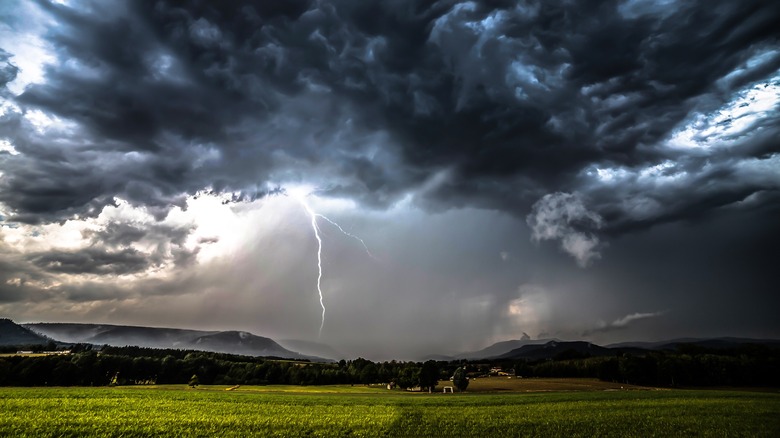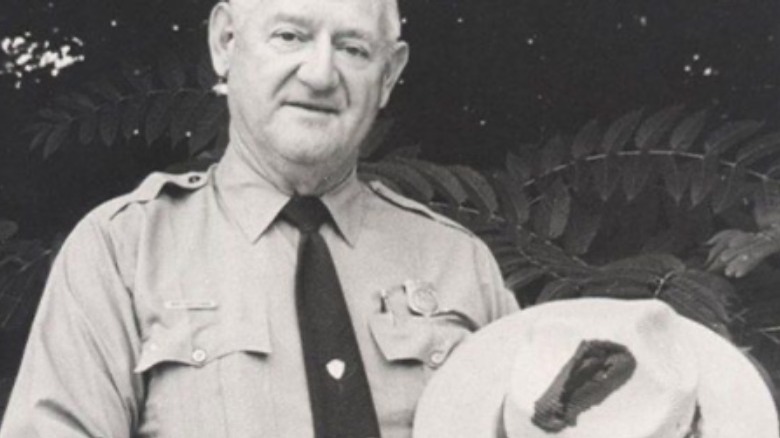The Sad Story Of The Man Struck By Lightning 7 Times
It's a distinction likely no one would want. Both terrible and fascinating, Roy Cleveland Sullivan holds the world record for "Most lightning strikes survived," by Guinness World Records.
According to Inside Nova, Sullivan was a U.S. Park Ranger in Shenandoah National Park in Virginia, so he spent a lot of time outdoors. Still, per Outside, Virginia isn't even on the top-10 list of biggest lightning hot spots, but lightning managed to strike Sullivan in the same basic geographic location seven times between 1942 and 1977.
Technically, Sullivan claimed to have had an early brush with lightning as a child when it struck a scythe he was using to help his dad cut wheat. Since there is no proof, that alleged eighth strike isn't counted, according to History of Yesterday.
The first documented time lightning struck Sullivan was in April 1942 when he was running from a lookout tower where he'd taken shelter from a storm. That tower had been struck multiple times, per Inside Nova, so Sullivan decided to run for it when lightning struck him in his leg. He lost a big toenail and a hole was burned in his shoe.
The next time was 27 years later in July of 1969 when lightning came in through an open window of the truck he was driving. Inside Nova reported he was knocked out for about 15 minutes and when he came to his eyebrows, eyelashes, and hair were all singed.
After the fourth strike, Sullivan was concerned a malevolent force was after him
According to the National Weather Service, the odds of being struck by lightning in an 80-year lifespan is one out of 15,300, but on average, only 10% of people who are struck die from their injuries, though the other 90% can be left with a variety of short- or long-term health issues. The odds of being struck in any given year are one out of 1,222,000.
Lightning basically made a mockery of those odds when it struck Sullivan for the third time just a year later in July of 1970. This time a bolt out of the blue struck Sullivan in the left shoulder, searing it, per Inside Nova. In Spring of 1972 — boom, again — the poor man was hit while inside a Shenandoah ranger station, his hair set on fire.
By now, Sullivan was starting to think some malevolent force was out to get him, and it's understandable, considering. Inside Nova reported he started carrying a jug of water with him in case he needed to douse his body after yet another lightning strike.
Two of the strikes happened only a mile apart
Sullivan was struck for a fifth time in August of 1973, as he tried to outrun a storm in his truck. According to History of Yesterday, he got out of the truck thinking he'd gotten away from the storm clouds when wouldn't you know it ... this time he had body burns and a shoe knocked off, but was able to crawl to his vehicle, grab his jug of water, and use it to put out the fire on his head.
Time number six was in June 1976. Sullivan was struck in the ankle while walking down a trail at the park, about a mile from where he was hit four years prior.
According to History of Yesterday, the sixth time was enough to make him finally retire from the U.S. Park Service and move to the ironically named town of Dooms, Virginia with his wife. But as we know, lightning wasn't done with the man who had become known as a "Spark Ranger" or the "Human Lightning Conductor" as Inside Nova reported he was nicknamed. It was to the point where people didn't even want to be near him if there was a storm around for fear they would be struck too.
The final strike was the worst
The seventh and final time Roy Sullivan was struck by lightning was while he was fishing. By now he was pretty experienced with the phenomenon, and according to History of Yesterday he said he "smelled sulfur" and the hair on his arms stood up right before he was struck. It hit him directly on the top of his head, for the third time setting his hair aflame. The final strike was also the most damaging, as it burned his chest and digestive tract and caused him to lose hearing in one ear.
The inexplicable way lightning seemed to seek out Sullivan is still not understood, but Richard Kithil, head of the National Lightning Safety Institute, told Outside of lightning, "It is entirely capricious, random, and unpredictable. Man's attempts to fit lightning into a convenient box, with codes and standards to describe its behavior, are a best guess."
For Sullivan, besides the physical pain and fear he lived with, he also endured loneliness due to people in the community avoiding being near him out of worry, History of Yesterday reported. Sullivan did have a wife and four children, and a large extended family though, per his obituary on Find-a-Grave.
Still, in the end, the man who lightning couldn't kill took his own life in September 1983. He was 71.



